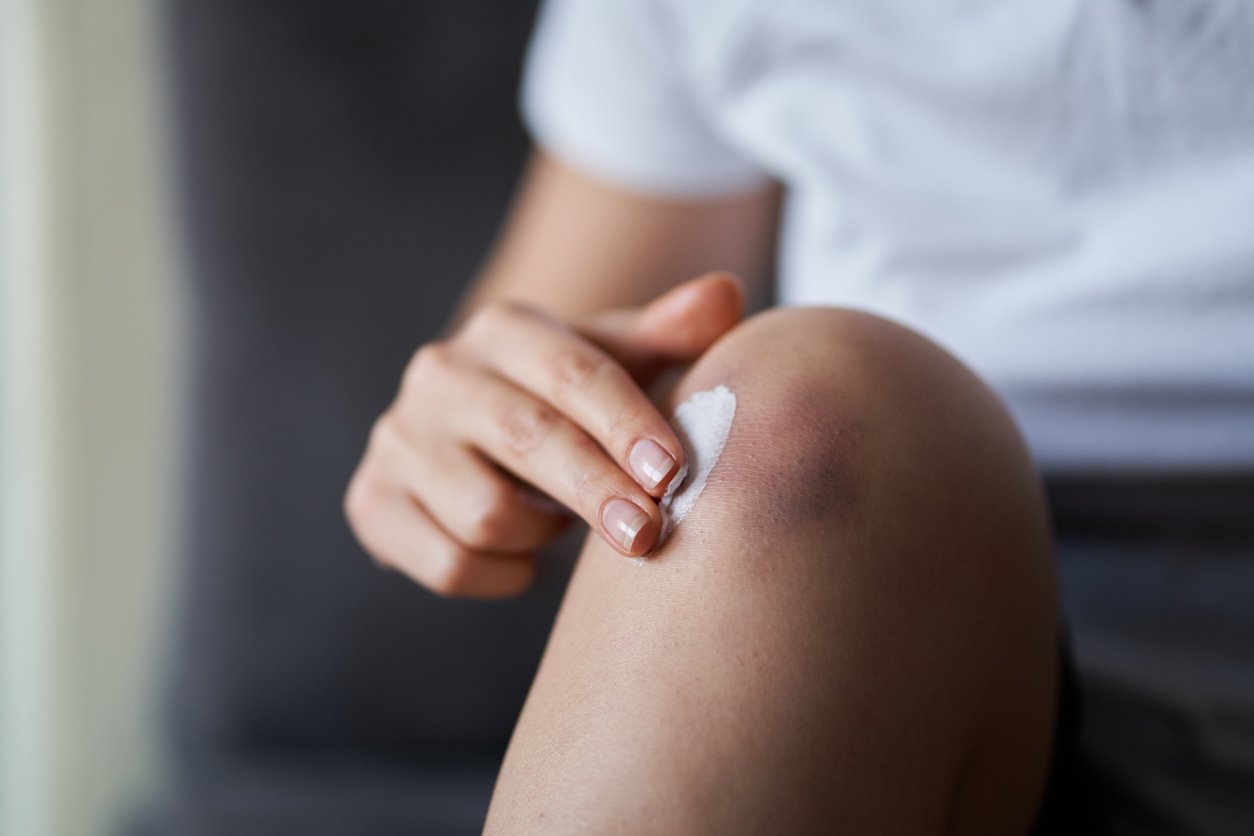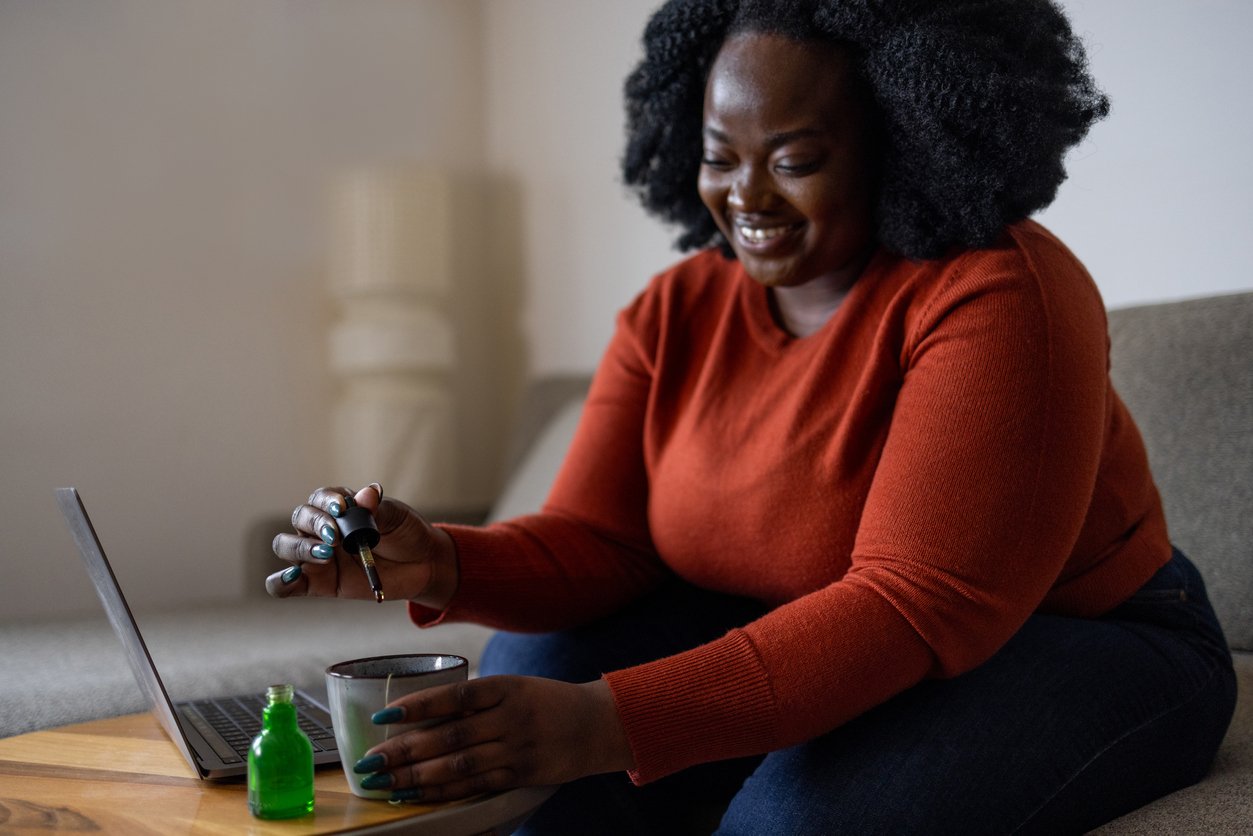By Brooke Klintworth, cofounder of SomaLeaf. This article concludes with an Editor’s Note linking to a SomaLeaf product that makes use of the best practices described in the article.
Have you noticed a lot of CBD talk in recent years? Or that you can suddenly find it almost everywhere? Well, that’s because, in 2018, the Farm Bill legalized the regulated production of hemp in the United States. When this bill was signed into law, it granted hemp manufacturers the right to mass-produce, sell, and transport hemp and hemp products — and for you to be able to possess and use it.
There was, however, one catch.
Hemp is the same plant species as marijuana, which contains the psychoactive cannabinoid known as delta-9-tetrahydrocannabinol (THC). And so, if hemp producers want to be within the legality of the Farm Bill, their products need to contain less than 0.3% THC.
This bill has had major implications for the natural health world. See, while THC produces the “high” associated with marijuana, there are loads of other cannabinoids within hemp that have been shown to be highly beneficial for human health without causing any psychoactive effects.
The 2018 Farm Bill — along with other more recent legislation — has opened up a whole new area of research into these cannabinoids. Previously, it was difficult to study beneficial cannabinoids due to the restrictions on hemp. So studies were few and far between. But now, scientists are finding out what some had suspected about certain cannabinoids all along — they appear to have extraordinary benefits for human health.
While there are numerous beneficial cannabinoids, in this blog, I want to talk specifically about one that has the most scientific research behind it: cannabidiol (CBD).
Not sure what CBD is — or why you should care about it? Well, keep reading! I’ll go over how CBD interacts with your body to support good health, its legality, types of CBD, and the best ways to take it.
CBD and the Endocannabinoid System (ECS)

Most people don’t realize that their bodies actually create cannabinoids on their own, contributing to a system within the body made up of molecules and receptors. Discovered only in 1988, researchers call this system the endocannabinoid system, or ECS for short.
With cannabinoids, along with their receptors, the ECS helps maintain a certain balance — or homeostasis — within the body, regulating functions related to pain, memory, appetite, and sleep, among others.
When a disruption in ECS homeostasis occurs, it’s known as an endocannabinoid deficiency. This is a situation where the body does not have enough naturally-made cannabinoids to attach to cannabinoid receptors. A deficiency in cannabinoids can throw the body out of balance and cause mismanagement of the ECS’s important functions.
However, a nonpsychoactive compound found within the hemp plant, CBD, can interact with the cannabinoid receptors within your body in astonishing ways. If you’re low in cannabinoids, think of CBD as supplementing these important compounds — enabling your body to find balance once again.
Plus, not only is CBD considered a multipurpose cannabinoid that can interact with many different receptors, it may increase the lifespan and amount of your body’s endocannabinoids, allowing your body to use more of what it’s already naturally producing.
By helping the ECS and supporting various other mechanisms throughout the body, (which you’ll learn about below), CBD may contribute to some remarkable health benefits.
So, without further ado, let’s learn about how this potent natural compound might be able to support your health!
1. CBD Sleep Benefits
If you have sleep issues, or if you just occasionally find yourself having a difficult time falling and staying asleep, consider adding CBD to your nightly regimen. There’s scientific research to back up the use of CBD as a support for relaxing and getting quality sleep.
When we’re stressed, our bodies produce a hormone called cortisol. Dubbed “the stress hormone,” cortisol can negatively impact sleeping patterns. But according to research, CBD could help regulate cortisol levels, helping us to relax.
In fact, a large case series from 2019 found that CBD use improved sleep in participants by nearly 67% after just one month.
And a 2023 systematic review of 34 studies showed that CBD alone (or in tandem with certain forms of THC) might improve symptoms of insomnia.
2. CBD and Joint Health

CBD has also been shown to help ease achy joints and promote a healthy inflammatory response. This is particularly important if you have a condition that causes discomfort within your joints.
For one thing, CBD has been shown to potentially increase the levels of anandamide in our bodies — a neurotransmitter associated with reducing pain perception and improving mood. And a 2021 study found that while CBD isolate oil didn’t reduce the volume of pain, it did make pain less bothersome.
And CBD doesn’t just make things feel better — it can also make them get better by helping manage the body’s response to inflammation. Research shows that CBD may reduce the levels of pro-inflammatory cells in the body while increasing the levels and effectiveness of crucial immune cells.
CBD has also been found to target the areas of the joints suffering from chronic inflammation in people with rheumatoid arthritis, potentially providing relief from uncomfortable symptoms.
And if all of that wasn’t enough, CBD might also help strengthen joint tissue. An analysis of CBD joint studies concluded that there is sufficient evidence that CBD may be able to both reduce cartilage degradation and facilitate cartilage repair.
3. CBD Brain Benefits
Cannabinoid receptors are dispersed throughout many brain regions and are responsible for regulating numerous aspects of activity within your brain.
As such, ongoing research is showing that CBD may have neuroprotective properties, specifically against cognitive decline and certain conditions and disorders of the brain.
One of the main factors in cognitive decline has to do with oxidative stress and inflammation. These states cause damage to neurons, inhibiting proper brain function. But CBD has been shown to offer potentially protective effects in the brain by reducing these factors.
A review from 2021 showed that CBD might be able to both repair and replace neurons, supporting cognition and brain health.
4. CBD and Mental Health

One of the causes of anxiety and depression is certain chemical reactions in the brain. It turns out that CBD may be able to reduce these symptoms by regulating chemicals in the brain.
For example, CBD has been shown to potentially help increase levels of what’s been dubbed the “bliss molecule” — a neurotransmitter called anandamide.
Researchers believe that a deficiency in endocannabinoids such as anandamide can lead to depression, migraines, and other conditions of the brain and nervous system. They also theorize that endocannabinoids like anandamide might offer protection against conditions like anxiety and depression.
It’s also thought that anandamide could help better regulate the body’s stress response.
And there’s another neurotransmitter CBD can influence — serotonin, a chemical that controls mood and makes you feel happy. Low levels of serotonin are linked to depression, anxiety, and mania associated with bipolar disorder. Though CBD isn’t thought to necessarily increase serotonin levels, it appears to change how your body uses the serotonin it does have, activating it and allowing it to better bind to serotonin receptors.
5. CBD and PMS
Chances are that you either know someone who gets menstrual cramps or you get them yourself. These types of cramps are quite common, with approximately 75% of menstruating people experiencing cramps during their periods.
Because of its natural ability to potentially alleviate discomfort and help manage the body’s inflammatory response, CBD is becoming increasingly popular to help relieve menstrual cramps.
A recent review of studies found CBD could be helpful in providing relief for many of the symptoms involved with PMS. Additionally, some researchers theorize that the main cause of menstrual pain — along with many other PMS symptoms — has to do with inflammation. CBD’s ability to affect the body’s inflammatory response is well documented. As such, it may help provide PMS relief by managing inflammation.
6. CBD and Hair Growth

While research is limited in this area, there are some interesting findings that show CBD intake might be able to contribute to increased hair growth.
Once again, it comes back to the ECS. Certain cannabinoid receptors have been found to be key players in hair follicle growth. As such, CBD may be able to help regulate the health of hair follicles.
Additionally, it may help regulate hormones which are often involved in hair loss conditions.
More research is needed, but it stands to reason that CBD might be helpful.
Is CBD Actually Legal?
Okay, so now you may be thinking, these benefits sound great — but I’m still worried about the legality of CBD.
Maybe a coworker told you that CBD isn’t legal everywhere, or you read somewhere that the lines are a bit blurry when it comes to what’s allowed and what isn’t. After all, you don’t want to get in trouble with the law, even if the health results from CBD are promising.
So, is CBD fully legal in the United States — or whatever country you live in?
Well, the fact of the matter is that it depends on where you live. In the US, as in many other countries around the world, there are both federal and state regulations on CBD use, as well as all other forms of the plant that CBD is extracted from — and they don’t always agree with one another. So it’s important to familiarize yourself with local as well as national laws concerning CBD.
Why is the issue of CBD legality complicated? It comes down to both how CBD is grown and extracted.
THC Levels and CBD Legality

CBD comes from a plant species called Cannabis sativa. Plants in this family include cannabis and hemp, which most people consider “sister plants.” The main difference between the two is that cannabis contains more THC — the cannabinoid responsible for the “high” feeling people get from marijuana — and hemp contains more CBD. Even so, some legislators worry that even hemp-derived CBD contains the illegal compound THC. This is why the 2018 Farm Bill clarified that hemp is only legal to produce if it contains less than 0.3% THC.
Essentially, CBD is legal in every state in the US, as well as Washington, DC. But many states have conditions.
While there are a number of states that have zero restrictions on CBD, just as many have certain conditions that need to be met if you want to purchase and use CBD. The main stipulation is that the THC level within the hemp plant the CBD was derived from needs to be at a certain percentage. Following the federal guideline, most are set at 0.03%. But some states allow zero traces of THC whatsoever.
Other states allow up to 0.05% THC, but you’ll need a medical license. And some don’t care about the percentage as long as the CBD is derived from hemp. Other states, like Mississippi, are a bit stricter and require you not just to have a medical license but to obtain CBD only from the University of Mississippi.
So, as you can see, it’s hard to say just yes or no to the question of whether CBD is legal within the United States. And other countries have their own rules and regulations, too.
CBD Types

So if you are able to obtain CBD legally, how do you know what kind to take?
There are many different methods that companies use to isolate and extract CBD and a range of ingredients they choose to add or leave in their products. In addition, there are also different blends that leave or take out flavonoids and cannabinoids. Some even completely isolate CBD on its own.
There are three main kinds of CBD products: CBD isolate, full-spectrum CBD, and broad-spectrum CBD.
CBD Isolate
CBD isolate is just that — pure CBD by itself without any other cannabinoids in the mix. Some people prefer it because it lacks any THC whatsoever. However, isolating CBD from all other cannabinoids requires the most lab processing of the three categories.
Isolate has similar health benefits to full- and broad-spectrum CBD, but lacks the so-called “entourage effect” that occurs with the presence of multiple endocannabinoids and related compounds.
Full-Spectrum CBD
Full-spectrum blends tend to increase in positive effects as the dosage is increased. However, while full-spectrum CBD must contain less than 0.3% THC, it may include trace amounts of THC, the active cannabinoid in marijuana products. Even though the amount of THC found in full-spectrum blends is generally too low to create a “high,” it does have the potential to show up as a positive on drug tests.
For some people, this is a deal-breaker. As we’ve seen, not all states allow CBD with THC above a certain level, or they require a medical card. And some people are also extremely sensitive to THC’s effects and don’t find it to be a positive experience even in tiny amounts.
Broad-Spectrum CBD
Finally, we come to broad-spectrum CBD blends. Broad-spectrum CBD means that all or some of the cannabinoids in the plant are extracted for the blend, minus THC.
My favorite broad-spectrum CBD products are processed in a way that retains all of the cannabinoids’ active properties. And there are quite a few cannabinoids besides CBD and THC (none of which are psychoactive, of course).
Another great thing about broad-spectrum CBD is it is less costly on average than full-spectrum products because the THC is left out. And it’s less heavily processed than CBD isolate.
What Type of CBD Is Best?
Ultimately, it depends on the person. Everyone’s bodies interact with CBD products differently. You may want to try out a few and choose the product that works best for you.
Are There Any Downsides to CBD?

As of the date of this article’s publication, the FDA “has not approved a marketing application for cannabis for the treatment of any disease or condition.” But a few cannabis-derived drugs have been approved.
However, since CBD (as with many supplements) is not regulated by the FDA in anything like the manner that pharmaceuticals are regulated, you may want to research the company and its production methods before purchasing. Some companies cut corners and use treatment and extraction processes that damage the purity and quality of their products, rendering them less effective than they could be — or worse, completely ineffective!
They could also contain unwanted contaminants such as pesticides, bacteria, and heavy metals. According to a report published by the CBD resource site Leafreport, 25% of the 136 brands they looked at did not conduct purity testing for their CBD products.
CBD can also potentially interact with certain medications, including anticonvulsants, sedative drugs, herbal supplements, and narcotics. Side effects can also sometimes occur, especially in high doses, and may include diarrhea, fatigue, vomiting, and drowsiness. I recommend consulting a medical professional before beginning a regular CBD regimen.
How Much CBD Should You Take?
While up to 1,500mg per day of CBD is seen as the tolerable upper limit for consumption, recommended amounts are usually much less.
Various factors may influence dosage amount, including body weight, the condition being treated, type of CBD, and sensitivity. When starting CBD, you’ll likely want to begin with a low dosage, which you can gradually increase as necessary. It may take some time and experimentation to find the right amount, as well as the right type of CBD product for you.
In the book CBD: A Patient’s Guide to Medicinal Cannabis by Leonard Leinow and Juliana Birnbaum, they break CBD dosage down into three categories: micro, standard, and macro.
- Microdose: 0.5mg–20mg of CBD per day
- Standard dose: 10mg–100mg of CBD per day
- Macrodose: between 50mg–800mg of CBD per day
Determining your dosage will also depend on the method you choose to take CBD, so let’s take a look at the types of CBD products that are available.
How to Take CBD

Now that we’ve covered the ins and outs of CBD, including its potential health benefits, you may be wondering how to take it.
There are many different CBD products, and the way in which they’re taken can affect the benefits you get, how quickly it works, and more. Determining what’s best for you may take a bit of experimentation. But as you’ll see, some are more reliable than others if you’re looking to get the maximum benefits out of your CBD usage.
CBD Edibles
CBD through edibles is a fun and easy way to consume the compound. You can do this through gummies, sweets, and even mints. Some food and beverage companies also make CBD-infused products.
Though easy to consume, there are some downsides. Some gummies may be made with gelatin, which could come from factory-farmed animals, and food and beverage products may also include natural and artificial flavorings and sweeteners.
Eating CBD also subjects the compound to something called the “first pass effect.” During this process, CBD is broken down by the liver and digestive tract. As a result, it can take several hours for the CBD to take effect, and you’ll likely only absorb 20–30% of it.
CBD Topicals
CBD topicals are meant to be applied directly to the skin. These can include lotions, creams, balms, ointments, and transdermal patches. This can be a great option for treating skin conditions or inflammation over specific areas of the body.
One study done on rats found that topical CBD greatly reduced joint swelling in the applied area, giving promise to those with arthritis.
However, skin can be hard for these compounds to penetrate. If you do go this route, it’s probably best to use a generous amount of a topical product that has a high concentration of CBD.
Vaping or Smoking CBD
You can smoke CBD in a joint, much like marijuana, use a vaporizer that has CBD oil in a cartridge, or inhale CBD concentrates using a vape pen.
With this method, the CBD hits your bloodstream much faster, and you will likely feel the effects rather quickly. Even then, only about 34–56% of the CBD will be absorbed.
However, taking CBD in this way, as with other smoke products, can also potentially expose you to harmful carcinogens. And research is still underway on the lasting effects of vaping. Based on a growing body of concern about the health effects of smoking and vaping, it seems that it may well be best to avoid this method.
CBD Tincture Oil
This is one of the simplest ways to take CBD. With CBD tinctures or sprays, you drop or squirt the CBD oil into your mouth and swallow. Like other herbal products delivered in this manner, you’ll want to hold the CBD beneath your tongue for a few moments, as the CBD can penetrate the thin tissue if allowed to linger.
CBD oil is a great way to get pure, high-quality CBD in a way that doesn’t have any risks like smoking or vaping.
However, because of its poor solubility, CBD taken this way isn’t absorbed very well, with some reports showing only a 13–19% absorption rate.
Liposomal CBD
Liposomes are membranous, fluid-filled sacs that can help in the delivery of cellular products. They occur naturally in the body, but may also be created synthetically. They’ve been shown to be extremely effective in delivering everything from vitamins to pharmaceuticals safely throughout the body.
Liposomal CBD facilitates survival in the acidic environment of the stomach and absorbs through the intestinal wall.
One study compared liposomal CBD with non-liposomal CBD. They gave the first group of participants standard, orally-administered non-liposomal CBD oil and the second group orally-administered liposomal CBD oil.
After one hour, the non-liposomal group only had 6 out of 15 participants showing CBD in the blood, while the entire liposomal group showed CBD in their blood.
On top of that, CBD levels were significantly higher in the liposomal group. The highest concentration of CBD detected at one hour was 5.9 ng/mL in the liposomal CBD group compared to a mere 1.3 ng/mL in the non-liposomal group. That’s nearly five times as much!
CBD Is a Promising Substance for Your Health

As you can see, CBD has a number of useful applications for your health, especially if you’re somebody already struggling with an issue like insomnia or joint pain, or are worried about cognitive decline.
Because there are different types, methods of consumption, and dosages, you may have to experiment a bit in finding what’s right for you. And it may be wise to work with a health care provider to avoid side effects and any potential medication interactions.
I don’t know about you, but with the increasing availability of CBD and research on its potential uses, I’m excited to see how it continues to help people with a variety of medical conditions.
Even though more research is clearly needed before we know all the pros, cons, and long-term effects of the different forms of CBD, many people are concluding that they’ve seen enough to want to give CBD a try and see how it works in their bodies.
Tell us in the comments:
- Have you heard of CBD or tried it yourself?
- Have you seen results with specific CBD products?
- What other questions do you have about CBD consumption?
Featured Image: iStock.com/ArtistGNDphotography



